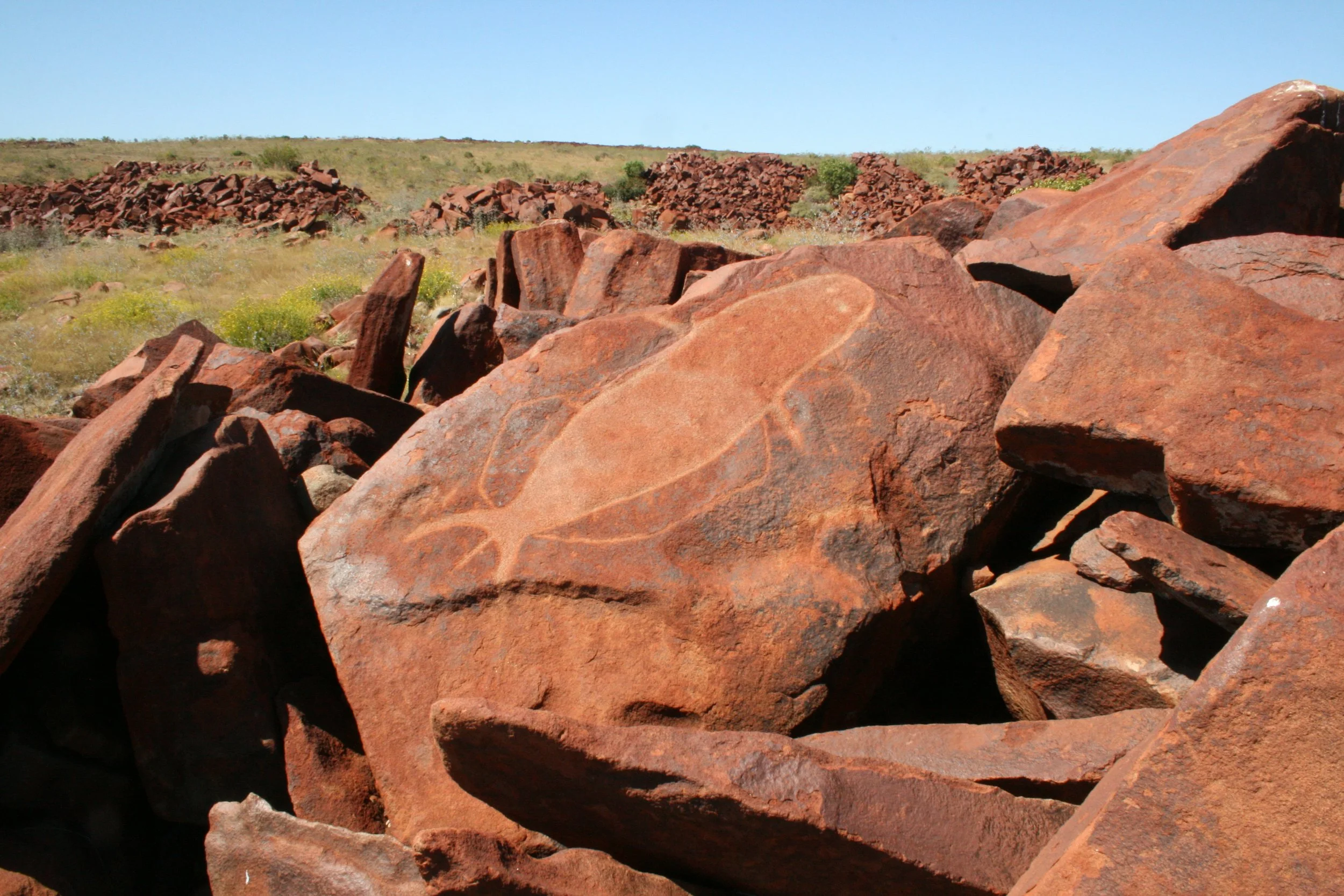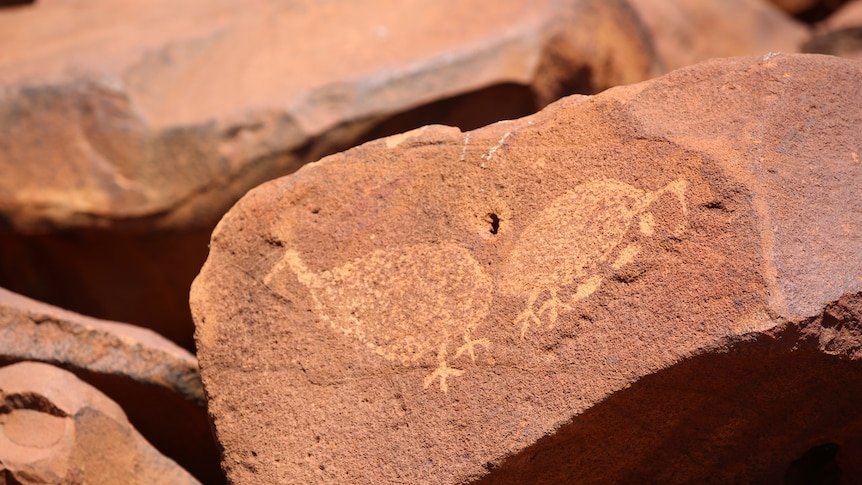About Murujuga
Murujuga, or the Burrup Peninsula, is a unique ecological, spiritual and archaeological area, containing the world’s oldest, largest and most significant collection of petroglyphs/ancient rock carvings, which record the survival of humankind over more than 50,000 years.
The Burrup Peninsula is located on the north-western coast of Western Australia within the Dampier Archipelago and is UNESCO World Heritage-listed.
The peninsula is part of the Dampier Archipelago which consists of 42 islands in a 45km radius. The Burrup Peninsula, approximately 27km long and 5km wide, was originally an island that formed part of this grouping until it was joined to the mainland in the mid-1960s by a rail and road causeway built by industry.
The original inhabitants of the Dampier Archipelago were the Yaburara people who were massacred over an eight day period in February 1868. This genocide occurred at various locations on the Burrup and in the waters of the Archipelago in what is referred to as the Flying Foam Massacre. The current custodians are the Ngarluma Yindjibarndi, Wong-goo-tt-oo and Yaburara Mardudhunera peoples.
All visitors must follow and respect the Murujuga Aboriginal Corporation’s Murujuga General and Cultural Protocols for Visitors.






Rock art
The Dampier Archipelago Rock Art Precinct comprises possibly the largest concentration of petroglyphs (rock carvings) in the world and also the largest number of megaliths (stone arrangements) known in Australia.
Estimates of the number of rock art motifs are currently over 1 million images, possibly closer to 2 million. There are many styles of carvings in the Archipelago, which are thought to represent a period from our recent history up to 50,000 years in age, straddling the last ice age some 17,000 years ago. The place constitutes the greatest continuous cultural site in the world as nowhere else is there such an unbroken history of human existence.
Illustration from Ken Mulvaney’s Burrup and Beyond, 2013 reprinted 2018.
The Archipelago is also a site of great aesthetic attributes, visual and non-visual, being the place where the magnificent hills of the Pilbara meet the Indian Ocean. It has considerable value as a geological showcase and it is home to three endangered animal species and 39 endangered or endemic plant species. It has impressive marine life (dugong, turtle beaches and whale nursery) and wetland areas. But its significance as Australia’s largest monument to Indigenous culture completely overshadows all its other qualities. Its importance to Australia and the world is apparent by the fact that it meets all of the nine criteria for World Heritage listing.
Petroglyphs are numerous in many other parts of Australia, but nowhere do they even remotely approach those of the Dampier Archipelago in terms of number, history, variety or continuity. The rock art of the Archipelago remains an important cultural focus for Aboriginal people in the region, comprising as it does many thousands of sacred images and ceremonial sites (e.g. tharlu increase sites). It remains an utterly sacred place not only to the local Indigenous communities, but also for all Australians and, indeed, the world. This quintessentially Australian and entirely unique cultural property has been included on the World Heritage List. It is a place of unparalleled artistic, cultural, religious and historical significance, as well as a place of magnificent natural beauty.
Government inaction
In 1962-64 the Western Australian Government determined to use Dampier Island (Burrup) in the Dampier Archipelago as the location of an outlet port for the iron ore industry. It did so seemingly on the basis of an incorrect report from the WA Museums department that had indicated that there were only 200 carvings in the Dampier Archipelago. By 1973, Enzo Virili had recorded 6,000 carvings on the Burrup in a 5 square mile area and 4,000 of these were in Gum Tree Valley alone. No further evaluation, that has been sighted, was ever carried out into the suitability of this area for industrial development, either based on site costs, environmental or heritage values.
Lieutenant General John Sanderson, then WA Indigenous Affairs Special Advisor, spoke about the need to protect the rock art:
“Absolutely. I mean this is an amazing collection of art. We are talking about tens of thousands of pieces of art, 20,000 years old carved in granite (sic)… We are talking about an ice age culture, we are talking about Aboriginal temples in the rock.”
However, despite numerous State government reports promoting industrial development on the Dampier Archipelago, none of them, until recently, have acknowledged the industrial impacts on one of humankind’s earliest and most significant heritage sites. Even with today’s knowledge of the archaeological and cultural significance of the area, the State government continues to invest in industrial infrastructure on the Burrup, stating that they are on track to turn the Burrup into the main industrial hub for the Asia Pacific region.
The 2018 report of the Senate Inquiry into the protection of Aboriginal rock art of the Burrup Peninsula stated:
“It is estimated that thousands of petroglyphs were destroyed during the construction of facilities on the Burrup Peninsula, and a number of others were collected and relocated. It is estimated that during surveys conducted in the 1980s for the Karratha gas plant situated in Withnell Bay, 9,500 petroglyphs were recorded, with approximately 4000– 5000 destroyed during construction.”
According to statements in Western Australian Parliament, over 941 petroglyphs were cleared to make way for Woodside’s Pluto LNG facility in 2006-7.
But the damage to the Murujuga rock art did not end with the construction of the LNG facilities. For many years, scientists and Traditional Custodians have been concerned that the remaining Murujuga rock art is being slowly dissolved by acidic pollution from these facilities.
Even the WA Environmental Protection Authority has raised the alarm, calling for an urgent inquiry. The WA Government has not responded to these concerns and Woodside continues to publicly deny that its pollution is harming the rock art.





